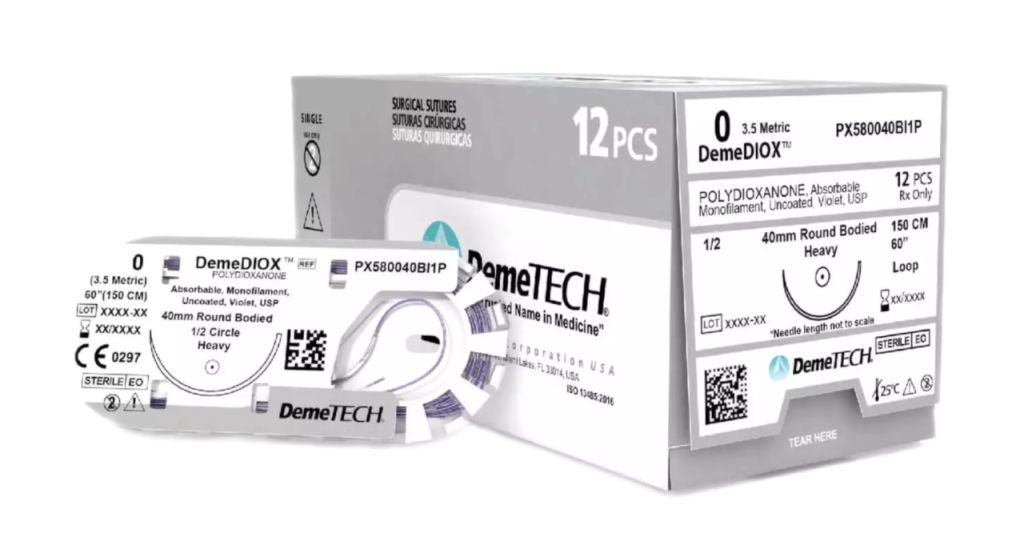Suture Material
POLYDIOXANONE monofilament synthetic absorbable suture is prepared from the polyester, poly (p-dioxanone). The empirical molecular formula of the polymer is Polydioxanone polymer has been found to be non-antigenic and elicits only a slight tissue reaction during absorption. Demetech Polydioxanone sutures meet the requirement of the current edition of the United States Pharmacopeia.
Polydioxanone (PX)

DemeDIOX ™ Polydioxanone (PX)
Intended Use
POLYDIOXANONE monofilament synthetic absorbable sutures are indicated for use in general soft tissue approximation, including use in pediatric cardiovascular tissue where growth is expected to occur and ophthalmic surgery
Actions
Two important characteristics describe the in vivo performance of absorbable sutures: first, tensile strength retention, and second, the absorption rate (loss of mass). POLYDIOXANONE synthetic absorbable suture has been formulated to minimize the variability of these characteristics and to provide wound support through an extended healing period. Data obtained from implantation studies show that the absorption of these sutures is minimal until about the 90th post-implantation day. Absorption is essentially complete within 180-220 days.
DemeTech’s Polydioxanone suture is an absorbable, sterile, surgical suture composed of the polyester, poly(pdioxanone). DemeTech’s Polydioxanone has been found to be nonantigenic and elicits only minimal tissue reactivity during the absorption process. Clinical trials have shown that after two weeks, approximately 75-80% of DemeTech’s Polydioxanone initial strength remained. At four weeks, approximately 65-70% of DemeTech’s Polydioxanone initial strength remained. At six weeks, approximately 55-60% remained. Complete absorption of DemeTech’s Polydioxanone is 180-220 days.
1DemeTech’s Polydioxanone sutures are available violet and colorless.
2DemeTech’s Polydioxanone is ideal for internal tissues where a long lasting, absorbable suture is preferable.
3As Polydioxanone is composed of synthetic materials, it elicits less reactivity than natural absorbable sutures. However, due to its prolonged absorption period, Polydioxanone may elicit some tissue reactivity.
4 The safety and effectiveness of POLYDIOXANONE sutures have not been established in neural tissue, adult cardiovascular tissue, or for use in microsurgery.
5 Under certain circumstances, notably orthopedic procedures, immobilization by external support may be employed at the discretion of the surgeon.
6 Do not re-sterilize.
Precautions
1 The POLYDIOXANONE suture knots must be properly placed to be secure.
2 As with other synthetic sutures, knot security requires the standard surgical technique of flat and square ties with additional throws if indicated by surgical circumstance and the experience of the operator.
3 As with any suture, care should be taken to avoid damage when handling.
4 Avoid the crushing or crimping application of surgical instruments, such as needle holders and forceps, to the strand except when grasping the free end of the suture during an instrument tie.
5 Conjunctiva and vaginal mucosal sutures remaining in place for extended periods may be associated with localized irritation and should be removed as indicated.
6 Sub-cuticular sutures should be placed as deeply as possible in order to minimize the erythema and indurations normally associated with absorption.
7 Acceptable surgical practice should be followed with respect to drainage and closure of infected wounds.
Adverse Reactions
Due to prolonged suture absorption, some irritation and bleeding has been observed in conjunctiva and mild irritation has been observed in the vaginal mucosa.
Polydioxanone, PX
These sutures are particularly useful where the combination of an absorbable suture and extend wound support (up to six weeks) is desirable.


